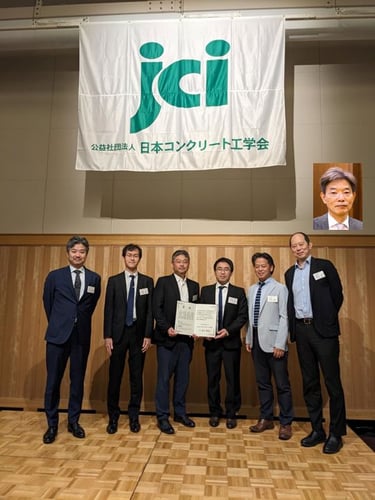Share this
On 22th June 2023, Professor Ippei Maruyama and Professor Takafumi Noguchi of the Department of Architecture, and other researchers received Japan Concrete Institute Award (Paper Award) .
Authors
Ippei Maruyama(Professor, Department of Architecture)
Wataru Kotaka(Completion of master's program of Department of Architecture in 2022)
Bui Ngoc Kien(Project Researcher, Department of Architecture)
Ryo Kurihara(Project Researcher, Department of Architecture)
Manabu Kanematsu(Professor, Tokyo University of Science)
Hikotsugu Hyodo(Taiheiyo Cement Corporation)
Hiroshi Hirao(Taiheiyo Cement Corporation)
Ryoma Kitagaki(Professor, Hokkaido University)
Masaki Tamura(Professor, Kogakuin University)
Masato Tsujino(Shimizu Corporation)
Satoshi Fujimoto(Associate Professor, Utsunomiya University)
Takafumi Noguchi(Professor, Department of Architecture)

Japan Concrete Institute Award (Paper Award)
The Japan Concrete Institute Award (Paper Award) is given to papers published in JCI publications that are recognised as having made an outstanding contribution to the advancement and development of science and technology related to cement and concrete, and the authors of such papers are eligible to receive the award.
About awarded research
"A New Concept of Calcium Carbonate Concrete using Demolished Concrete and CO2"
Currently, carbon neutralisation is an urgent issue in the concrete sector because of the high CO2 emissions in concrete production. This is the first paper from the NEDO Moonshot Project. Prof. Takafumi Noguchi is the PM, proposing a completely new calcium carbonate concrete, using calcium carbonate as the binder. This paper, led by Professor Ippei Maruyama, who had been conducting research on carbonated concrete in the geological field, hypothesized a reaction mechanism and demonstrated that a hardened body could be produced using calcium carbonate as the binder. This research is a technology that, when put into practical use, will enable significant reductions in CO2 emissions and resource input because it uses concrete waste, fixes CO2 in the air, and ultimately makes the material itself recyclable.
Your impression & future plan
The project is progressing well, and we will continue our research with a view toward practical application.
These Related Stories


